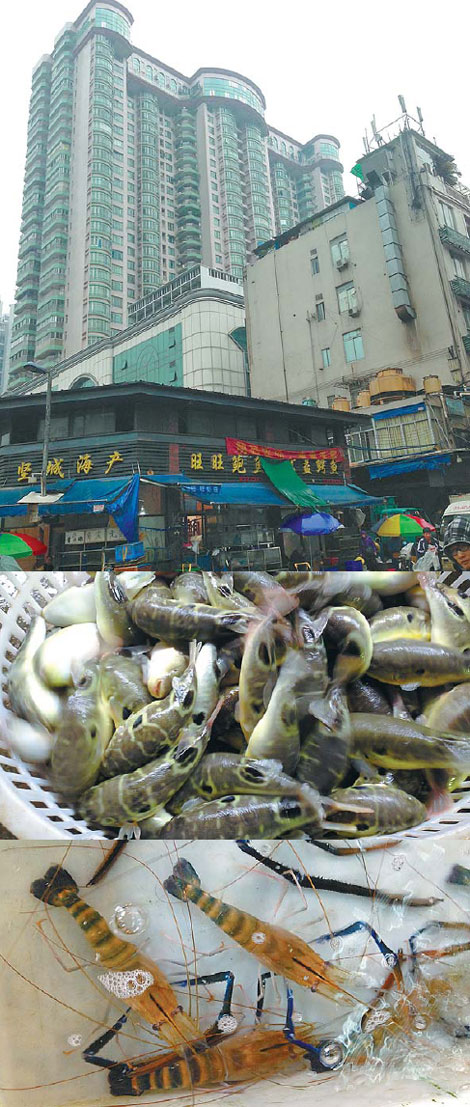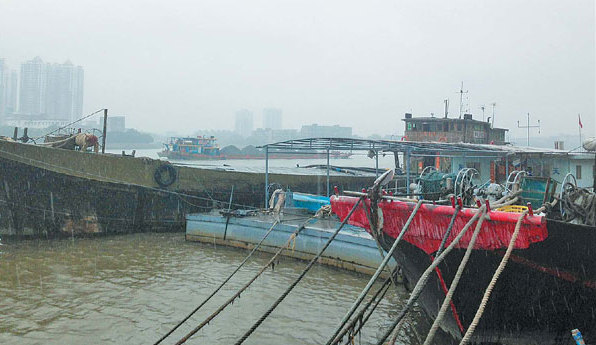Fish, shells and crustaceans
Updated: 2013-04-14 08:08
By Pauline D. Loh(China Daily)
|
|||||||
|
Top: Huangsha market is located against the background of high-rise buildings. Middle and above: Puffer fish and blue beauty prawns. |
Guangdong or Cantonese cuisine is known for its insistence on the freshness of ingredients. Pauline D. Loh finds out exactly how high the bar is raised.
Every Cantonese chef or serious home cook would have visited Guangzhou's Huangsha seafood wholesale market at least once. It is the mecca of freshness, where everything is breathing, swimming or wriggling.
Located along the river in the Lizhiwan or Lychee Bay area, it commands a huge spread of land that is escalating in price every day.
Property developers are invading its fringes, building high-rise, high value condominiums that cost a cool couple of millions each. That is the reason why there have been so many attempts to get the sprawling wholesale market to move - but with little success.
It is obvious that while Guangzhou natives love the profit like everyone else, they love their food better.
So, Huangsha market is safe for the moment. Every day starting from the early hours of the morning, the fishing boats and container trucks roll in, bringing in the freshest fish, prawns, crabs and shellfish not just from all parts of China, but from all over the world.
From Norway, salmon arrives and there are specialist shops where the large fish are delicately and precisely cut into fillets and steaks that gourmet shoppers can buy home.
One of the first shops we visited had a huge display window where you could see the masters carving up the cuts while apprentices watched and learned the craft.
Further in, the market divides into areas where the chefs can shop according to the seafood categories.
The first area is dedicated to crustaceans of every sort. There are local farmed prawns, huge red prawns imported from the other side of the Pacific, flower prawns from the South China Sea, and pretty blue-clawed prawns that come from Thailand that are valued for their large heads full of coral.
They are of all shapes and sizes, but they must all be swimming and alive, because here at Huangsha, a dead prawn is considered bargain basement goods.
Crab varieties are more dictated by season, although we see plenty of the Alaskan king crabs, just one of which would take up a whole display case.
And then I see something which stops me in my tracks - a whole basket of rare "yellow oil" crabs full of gleaming golden roe. These are actually normal mud crabs with an abnormal condition. In humans, we would describe it as having a fatty liver.
The roe-filled crabs are a particular delicacy and much prized in the kitchen where they are made drunk with a spoonful of liquor before they are cooked so they do not lose any of the precious roe if they should struggle in the steamer.
Huge lobsters, both the ones from the surrounding seas and the colorful blue lobsters from Australia are also available, and here, they are sold at wholesale prices that you cannot get anywhere else in the country.
Ben Huang, the Chinese executive chef of the Four Points Sheraton in Guangzhou is my guide, and he is a walking encyclopedia of all the various fishes that we see next.
Spotted groupers, flower groupers, star groupers swim in huge aquariums, oblivious to the hungry eyes that are weighing up their suitability for the dinner table.
Chef Huang says that the best size for a classic Cantonese steamed fish is a 1 kg fish. Any larger and the flesh would lose its smooth silky texture.
Huang also points out the sea eels, the rabbit fishes and the flounders that are popular in various other dishes. The variety is amazing and the amount of cash that passes through here is equally astounding.
As we pick our way among the aquariums, we see a wriggling basket full of puffer fish. Startled, I turned to the chef with raised eyebrows.
"These are legal. They are raised on government-approved farms and they are not toxic," Huang assures me. In fact, the chef says, they are a popular dish in his restaurant, where they are cooked whole, with shredded white radish.
If a swimming fish fetches just 50 to 100 yuan ($8-16) per kg, one shop does about a ton of business each day and there are close to 100 shops here selling fish. You work out the mathematics.
We move on to the area nearest the water and this is where the shellfish rule. Again, it is an open-mouth experience. There are the familiar cockles, clam and razor clams, but there are also sea snails, whelks and conches that I have never seen before.
The cockles alone range from nut-sized shells that are simply quickly blanched and eaten dripping with red juices to huge monsters as large as my fist.
Chef Huang's eyes lit up and for once, he starts asking about prices. Before long, we are carrying a heavy black bag of about a dozen shells.
How are we going to eat these, I ask the chef.
"Sashimi," says the chef, smiling. I knew we would be in for a treat.
Before we leave, we watch as one of the last fishing boats unloads its catch by the wharf. The smell of the salt sea breeze wafts by, and we forget for a moment that we are in one of the busiest cities in China.
Huangsha wholesale market is one of the largest seafood centers in the country, and it still goes by the mantra that has governed Cantonese cuisine and made it unique both in China and abroad.
It is based on one simple word: Fresh.
Contact the writer at paulined@chinadaily.com.cn.
|
Fishing boats unload their cargoes of fresh seafood at the wharf at Huangsha every morning. Photos by Pauline D. Loh / China Daily |
(China Daily 04/14/2013 page14)

